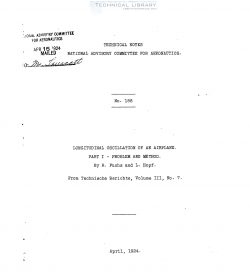naca-tn-188
- Version
- 107 Downloads
- 1.86 MB File Size
- 1 File Count
- November 4, 2016 Create Date
- November 4, 2016 Last Updated
National Advisory Committee for Aeronautics, Technical Notes - Longitudinal Oscillation of an Airplane - Part I - Problem and Method

All aerodynamical calculations, which form the basis of the
designing and analysis of airplanes, are founded upon an assump:,_::
tion of uniform steady motion. There are, however, many prob—
lems of practical importance which cannot be disposed of by
means of such calculations. To these belong all questions re-
lating to maneuverability and to the maximum stresses undergone
during flight. Such problems have hitherto been solved by apply—.
ing established scientific principles relating to steady flight,
as conformably to the facts as possible and, where this method
was not practicable, by relying in individual cases, on the
opinion of the pilot. If, however, aerodynamics is to afford a
wider basis for the art of flying, it must elucidate the prob~
lems of accelerated and disturbed motion, phenomena in an acci—
dental or intentional disturbance through the deflection of the
rudder or elevator, or any other change in the conditions of
flight.
Our experimental knowledge is sufficiently extensive to af—I
ford, in many instances, the necessary basis for the mathematical
analysis of these phenomena and, where such is not the case, the
theoretical investigation of the problem can indicate the neces-
sary experiments on models and actual flight.
The treatment of the whole problem may, at first, appear
hopeless to the theorist. The problem is that of a body with
six degrees of freedom moving in a fluid (air) and on which
forces are acting, whose relation to the position of the body is
only known empirically. Bryan's great service is the circum-
vention of these difficulties by the method of small oscilla~
tions and the Opening of a way for the treatment of these prob—
lems, even though the method is restricted to simple conditions.
The method of small oscillations is only applicable to condi~ .
tions in the neighborhood of a known state of equilibrium and,
as applied to the present instance, is as follows:
An airplane is in steady flight along a given line. The
quantities which determine its position and conditions of flight
(namely, velocity, angle of attach, slope of the flight path,
angle of bank, rate of side—slipping and curvature of flight
path) are all interdependent, When.the engine generates a defi-
nite propeller thrust and the rudders have a definite position.
The values of the above quantities are determined by the condi—
tions of equilibrium in steady flight, which have never been
satisfactorily discussed. If one or more of these variables
have not the value required by the conditions of equilibrium,
then the oscillation cannot be steady. It is simply assumed
that none of these variables differs greatly from the value core _
responding to equilibrium in steady flight.
| File | Action |
|---|---|
| naca-tn-188 Longitudinal Oscillation of an Airplane - Part I - Problem and Method.pdf | Download |

Comment On This Post